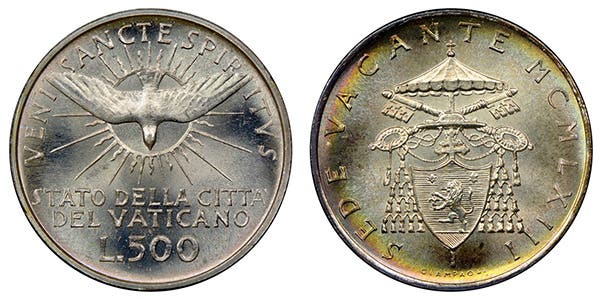Canada’s $2 coin now 20 years old
By Kerry Rodgers On Feb. 19, 1996, Canada’s Public Works minister, Diane Marleau, introduced the country to its spanking brand-new, 28 mm, $2 coin, KM-270. It was different. For starters…
By Kerry Rodgers
On Feb. 19, 1996, Canada’s Public Works minister, Diane Marleau, introduced the country to its spanking brand-new, 28 mm, $2 coin, KM-270. It was different.
For starters it was bimetallic, a first for any circulating Canadian coin. The font used for the obverse legend, ELIZABETH II / D.G. REGINA, differed from that of existing Canadian coins. And the date was shown on the obverse. Other coins had it on the reverse.
Despite these innovations Canadians had few issues in accepting their new coin as a substitute for $2 notes. They had gotten well-used to the idea when a $1 coin replaced the $1 note in 1987. They certainly approved the polar bear design of artist Brent Townsend on the reverse. And the new $2 became an assured winner once it had been dubbed “Toonie” [‘two’ plus ‘loonie’] following on from Canada’s Loonie dollar.
As a consequence, this past Feb. 19, the Royal Canadian Mint had every reason to celebrate 20 most successful Toonie years. In that time the Mint has struck 883 million of the coins for circulation with 375 million produced in the first year alone. Currently the Mint’s Winnipeg plant averages 510,000 new Toonies per day. Each comes with a life expectancy of over 20 years.
For the first 16 years that core consisted of a copper alloy (92 percent copper, 6 percent aluminum, 2 percent nickel) with the ring made up of 99 percent nickel. The two yielded a lighter (7.30 g) and thinner (1.8 mm) coin than found among similar, circulating, high denomination, bimetallic issues elsewhere in the world.
Throughout the 20 years that inner core and outer ring have been bonded by a patented locking system developed by the engineering division of the RCM.
In 2012 the Mint introduced a series of security upgrades for both the Loonie and Toonie. These saw the inner core of the Toonie become aluminum-bronze plated with multi-ply brass. The outer ring switched to steel plated with multi-ply nickel. As a result the overall weight was reduced to 6.92 g and the thickness to 1.75 mm, KM-1257.
The Multi-Ply Plated Steel (MPPS) technology was already in use for Canada’s smaller denominations. It provided each with a distinct electromagnetic signature that makes them far harder to counterfeit than conventional alloy coins. It is also markedly cheaper. With the $2 the ring holds the magnetic signature. The core does not.
In addition to MPPS, other new security features included two laser-engraved maple leaves, each within a circle, at the bottom of each coin’s reverse; a virtual image of two maple leaves at the top of each coin that displays different views as the coin is tilted from side to side; the words CANADA and 2 DOLLARS engraved along each coin’s outer edge.
In 2013 the International Association of Currency Affairs recognized these developments as affording the best coin security in the world.
In 2003 the obverse effigy of Her Majesty Queen Elizabeth changed from that of Dora de Pédery-Hunt, that had served from 1996, to that of Susanna Blunt, KM-496. The latter continues to the present.
On the reverse Townsend’s design has been retained throughout the 20 years but has not always been used for circulation coins. For example, in 1999 it appeared in a limited number of collector coin sets only.
Nine alternative reverse designs have appeared in circulation. These include:
The founding of Nunavut, 1999, KM-357, used on all general circulation $2s that year;
Path of Knowledge, 2000, KM-399, used on all general circulation $2s that year;
Toonie 10th anniversary, 2006, KM-836, circulated alongside the traditional polar bear;
400th anniversary of Quebec, 2008, KM-1040, circulated alongside traditional polar bear;
Boreal forest, 2011, KM-1167 circulated alongside traditional polar bear;
HMS Shannon, 2012, KM-1258, circulated alongside traditional polar bear;
“Wait for me daddy”, 2014, KM-1711, circulated alongside traditional polar bear;
Sir John A. Macdonald, 2015, KM-, circulated alongside traditional polar bear;
Flanders Fields, 2015, KM-, circulated alongside traditional polar bear.
As President and CEO of the Royal Canadian Mint, Sandra Hanington, has rightly observed, “Over the last 20 years, our $2 circulation coin has efficiently served Canadian commerce and given the Mint many opportunities to celebrate Canada through special commemorative designs. It is now time for us to shine a spotlight on the Toonie by wishing it a happy 20th birthday.”
In Campbellford, home to the polar bear reverse designer, Brent Townsend, the community has erected a 27 ft. “Big Toonie” similar to Echo Bay’s “Big Loonie” and the “Big Nickel” in Sudbury.
This article was originally printed in World Coin News.
>> Subscribe today or get your >> Digital Subscription
More Collecting Resources
• Come on down to the Chicago International Coin Fair in Rosemont, Ill. on April 14 to 17, 2016 to see impressive world coins, meet new collectors and participate in Heritage Auction’s fantastic coin auction.
• Keep up to date on prices for Canada, United States and Mexico coinage with the 2016 North American Coins & Prices guide.








